Aircat
Oceanic
Building the aircraft at Cyber-Rochester

Aircat
I can tell that modelling Aircat is going to be a challenge - there are lots of strange shapes that morph into other strange shapes. To be kind to myself I started with the main wing as that looks relatively straightforword. I set up Cyber-Rochester, Rochester on Medway in the UK being the home of the great Empire Class flying boats.
The Aircat wing is a special thing and so much more than a conventional wing. It is the structure that holds the whole plane together - the two hulls with the engines, and the tail - so it has to be very strong. Further it is as much fuselage as wing. It contains a significant amount of cabin space. Because of that the middle section is thick - several metres thick. That thickness wouldn't work along the whole wing so it has a significant taper. That gives it its unique shape.
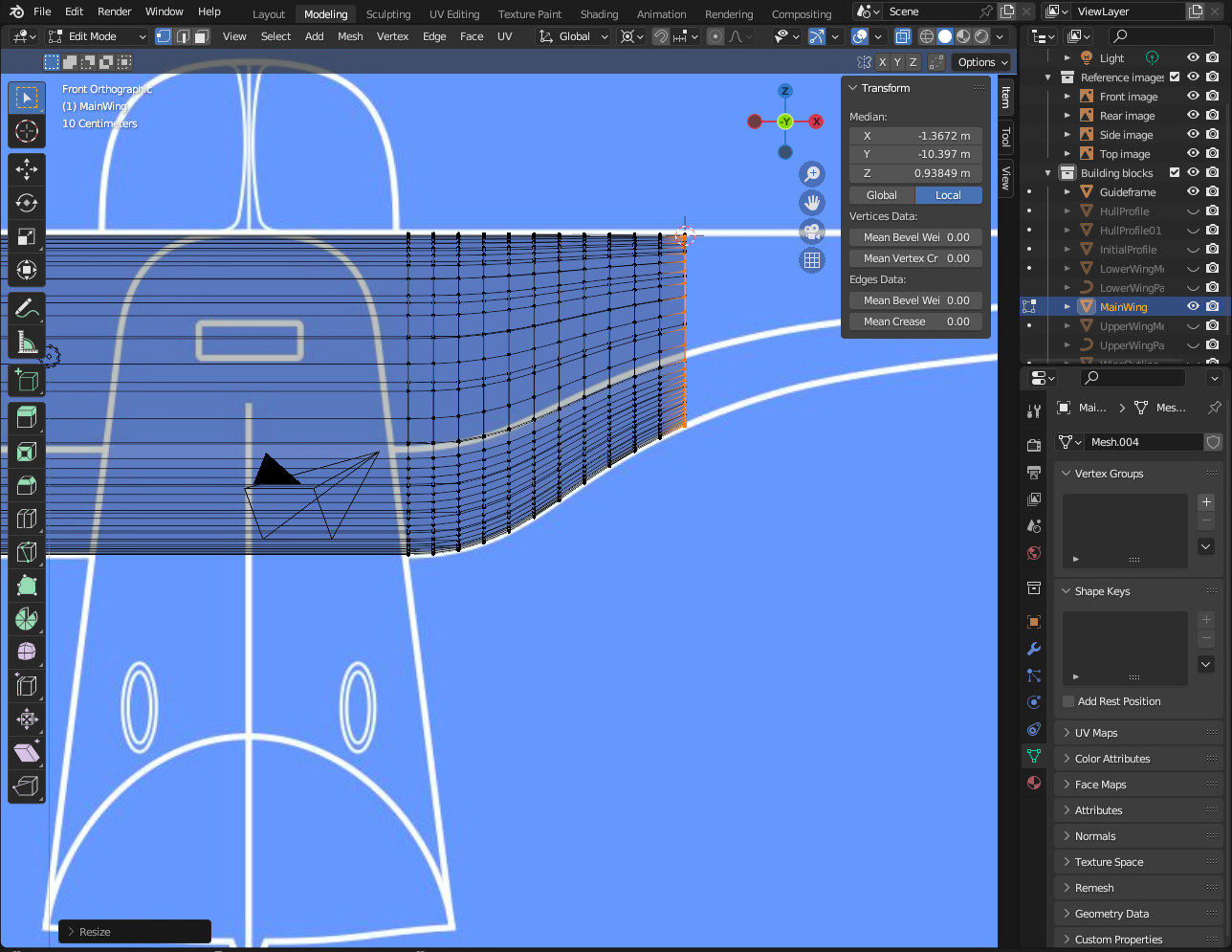
In those parts where the taper is greatest I'm creating a lot of geometry to ensure a smooth finish. As the taper reduces towards the end of the wing I reduce the geometry. I kept the number of vertices on the top half of the wing the same as on the bottom half of the wing. This makes closing off the wing geometry at the tip a bit easier and neater.
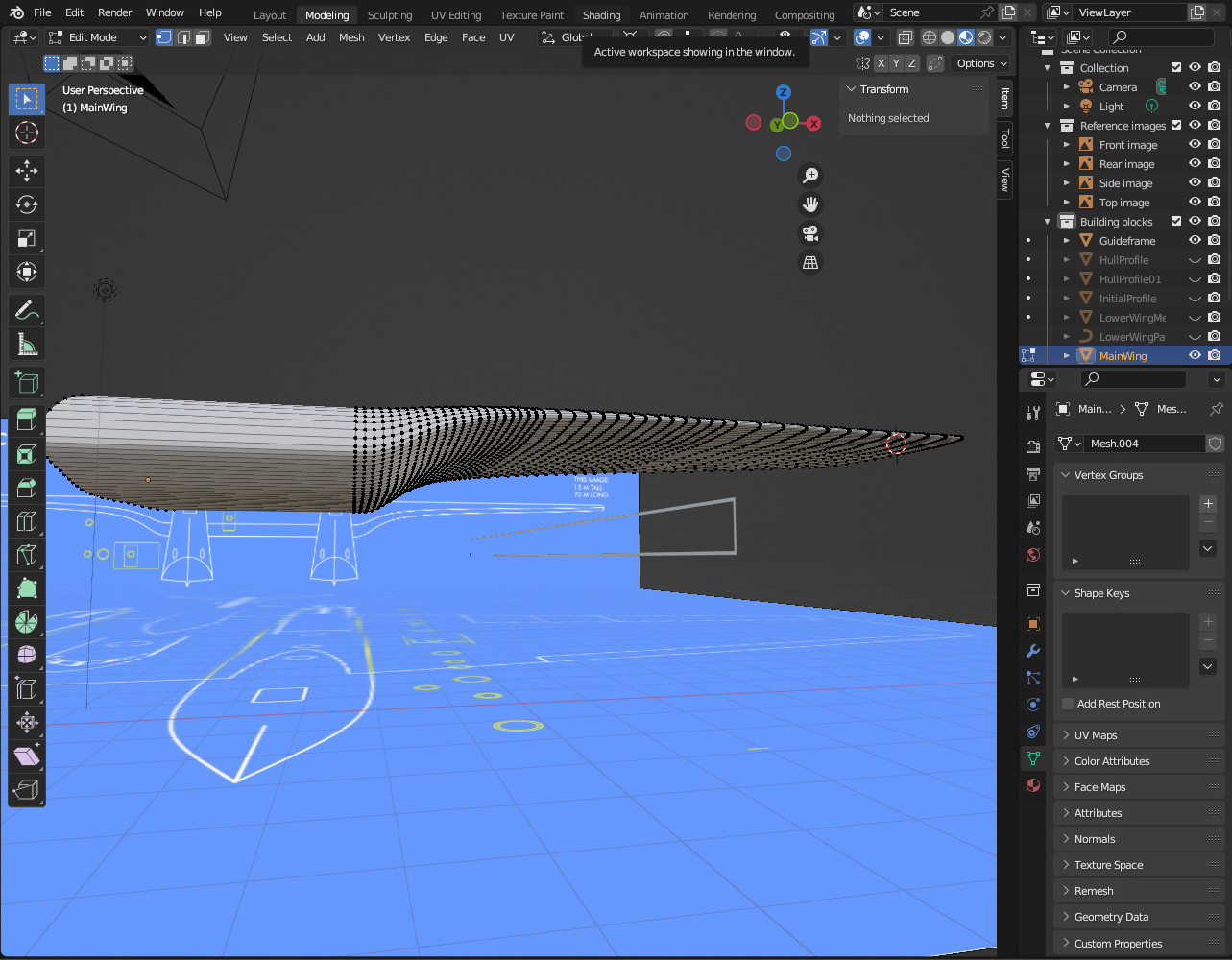
The movable flying surfaces are always a good challenge. I select vertices and then duplicate or delete them to create the basic shapes. In the past I've used custom orientations to reduce the size of the flaps and ailerons a little to create small gaps between them and the main wing. This time though I used very precise knife cuts to get to the sizes I wanted. That worked just as well.

Now those hulls are going to be very challenging.
Aircat hull
The Aircat hull is a very challenging shape - but in a good way. I'm trying to merge the aerodynamics of an aeroplane with the hull of a boat, and add a couple of jet engines. What could possibly go wrong!
I started with the front of the hull. If you look at the references, the large flying boats had tall fuselages to keep wings and engines well away from the water. Aircat follows this design pattern. The hull contains two levels of accommodation requiring several metres of height. As you move towards the front of the hull, the height decreases for the sake of aerodynamics, the width remains the same for the sake of internal accommodation, but the bottom of the hull must be shaped to cut through and remain stable in water. All this comes together at the nose - have a look:
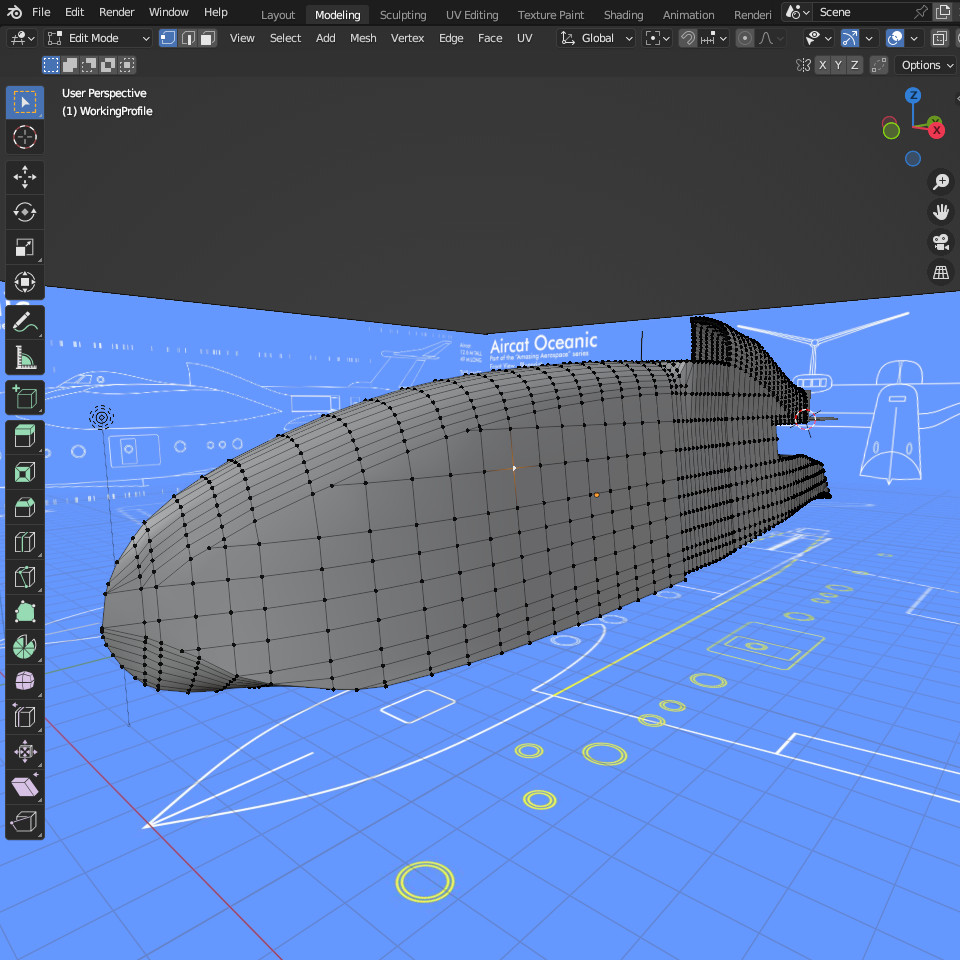
The lower part of the hull not surpringly is the most boat like as this is the part that actually sits in the water. During take off and landings it also has to give the plane directional stability in the water. I included a step in the hull. Steps reduce drag which is important when the plane is accelerating to take off. I threw in a couple of graceful curves thinking about how the water would react with the hull on landing. I formed those curves by extruding then rotating that surface. I think it came out quite well.
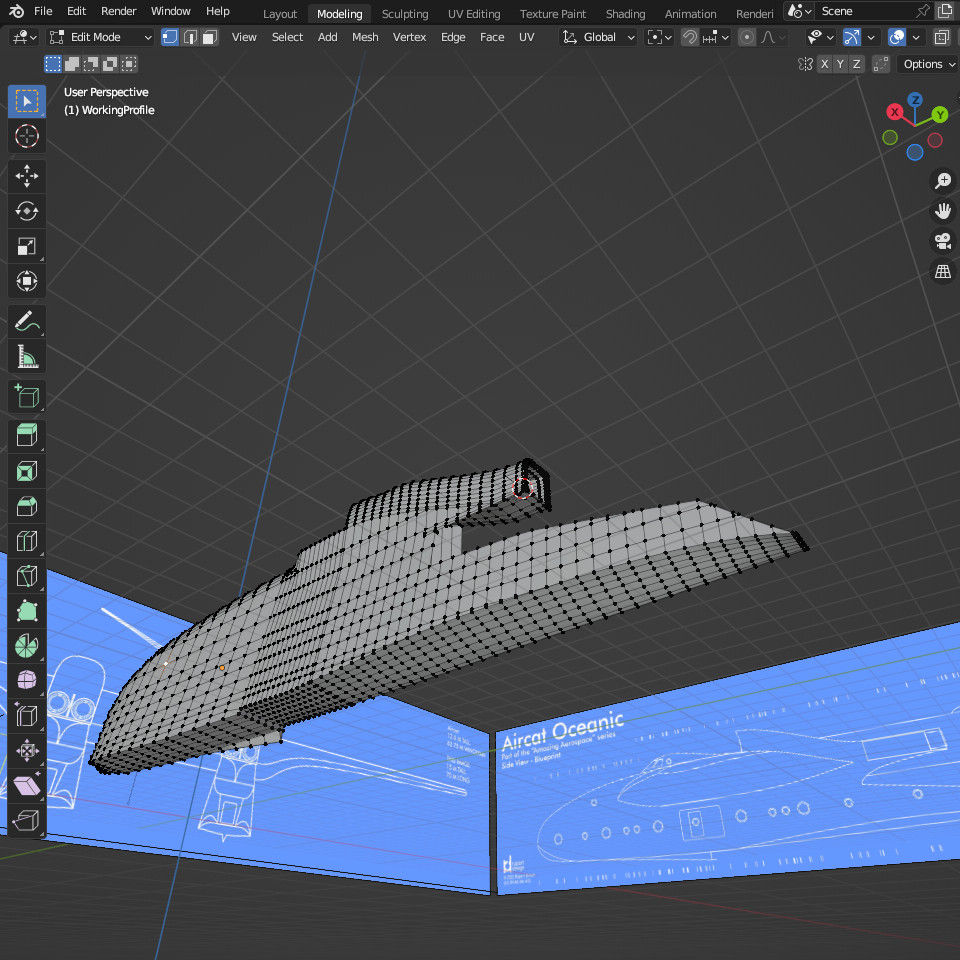
The top part of the hull is the air intakes for the engines and the engine mounts. The intakes sit above the wing to reduce the chance of ingesting too much water. The intakes funnel the air to engines towards the back of the hull - to balance that heavy nose around the centre of the wing - and to sit in line with the centre of mass. The air intakes were relatively straightforward, the only complication being blending them with the slightly wider fuselage.

The final piece of the puzzle is also the most complex. I'm still working on how to get it right. It's the section between the lower rear hull and the engine mount. It is supposed to be an engine mount support, and in doing so tapers to a fine edge across its height. Still a work in progress.
Aircat windows
Windows always seem to be problematic. You do your best to create beautifully smooth surfaces and then you have to punch a hole through one to create the window, and some weird geometry in the process.
There are several ways to do it including using the boolean modifier. That does work but I've found that it can be a bit of a blunt instrument and often it is hard to control the outcome - which is where you end up with that weird geometry.
My preferred method at the moment is to take a very planned approach to the creation of the geometry needed to spport the window. On Aircat there are two sizes of window - or porthole. I took the design decision to base the smaller porthole on a circle with 24 vertices. That provided the right balance between getting a good circle shape and not creating too much geometry. The process is:
- Position the porthole circle in the spot where you want the window. Be mindfull of the geometry of the mesh it will be created in. If possible choose a flat face. Orientate the circle to the face - align their normals if possible.
- Using the shrinkwrap modifier, project the circle onto the face. This should ensure that the vertices of the porthole circle are aligned with the face of the mesh. If all looks good, apply the modifier.
- Delete the face of the mesh that the porthole circle was shrinkwrapped to - you'll recreate new faces.
- Use the edge subdivider function to create the same number of vertices around the circle as are contained in the circle.
- Join up those vertices with new faces to create the window hole.
That sounds quite complicated. This picture should make it a lot clearer:
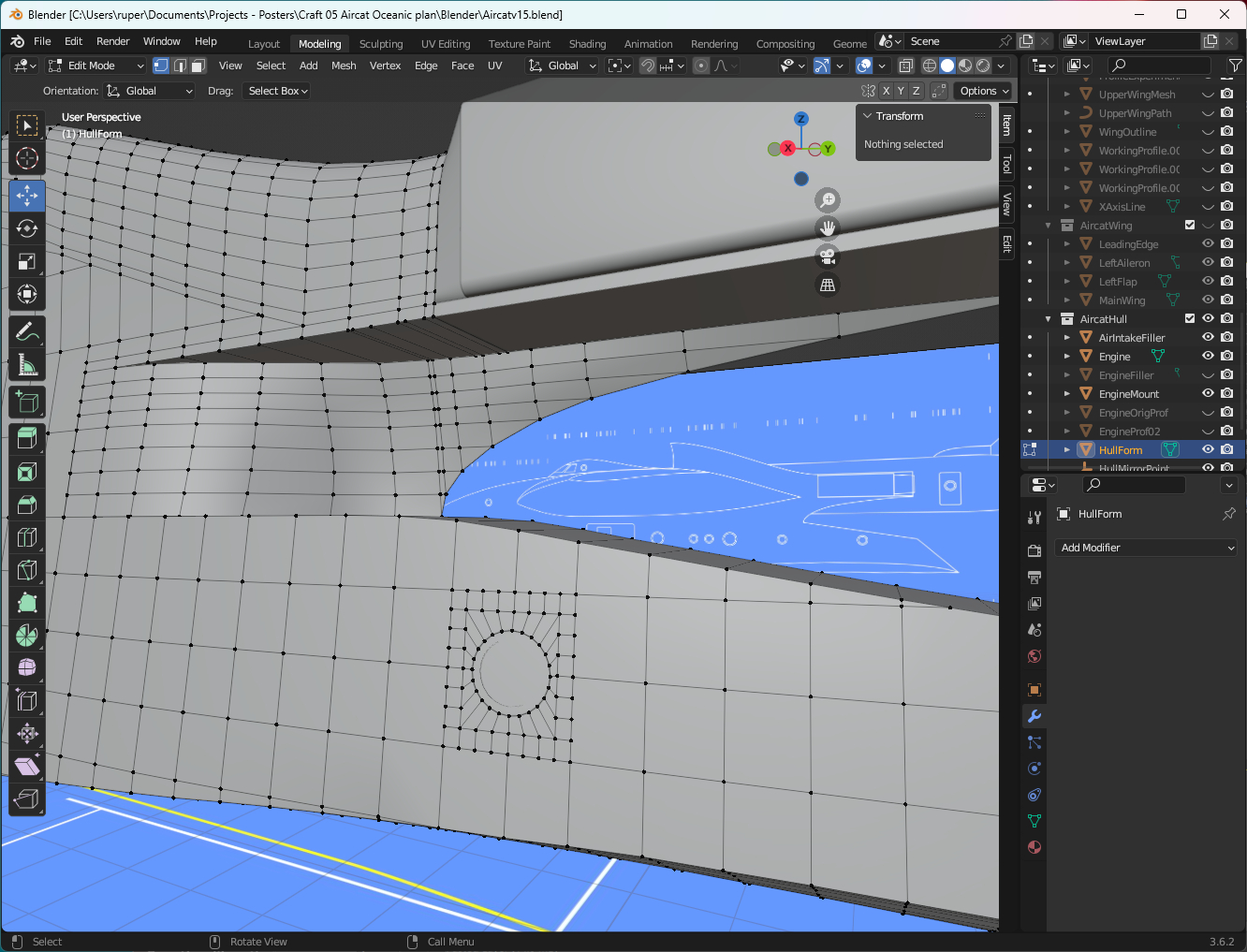
That creates the hole for the window. You then have to decide what the window fitting itself looks like. For Aircat I followed a similar design to that of Tarkine. The figure below shows the Aircat hull with most of its windows and doors installed. The Aircat hull is not symmetrical. The outer facing part of the hull has more windows than the inner facing part. Something to be mindful of before applying any mirrors.

Aircat tail
As a flying boat, Aircat needs a high tail to keep it clear of the water and I have unashamebly pinched one of the best looking tails in the business - from the marvelous Handley Page Victor. What an aeroplane that was - in another time it would have been Darth Vader's choice for a private jet.
Like wings, tails are aerofoil shapes and lend themselves to being modelled using bezier curves to get the initial forms correct. That is what I did in this case. I used a lattice modifier to get the right kind of taper across the length of the flying surfaces. I used some of the existing geometry of the tail components and the knife tool to cut out the moving parts of the flying surfaces.
All movable parts have a very small gap between themselves and the fixed parts - obviously to allow them to move. After trying lots of different ways of doing this, the method I prefer is to use the knife tool and slice off very thin strips of mesh from the movable parts. I think that keeps shapes in their truest form - rather than scaling or moving. This is how the tail turned out:
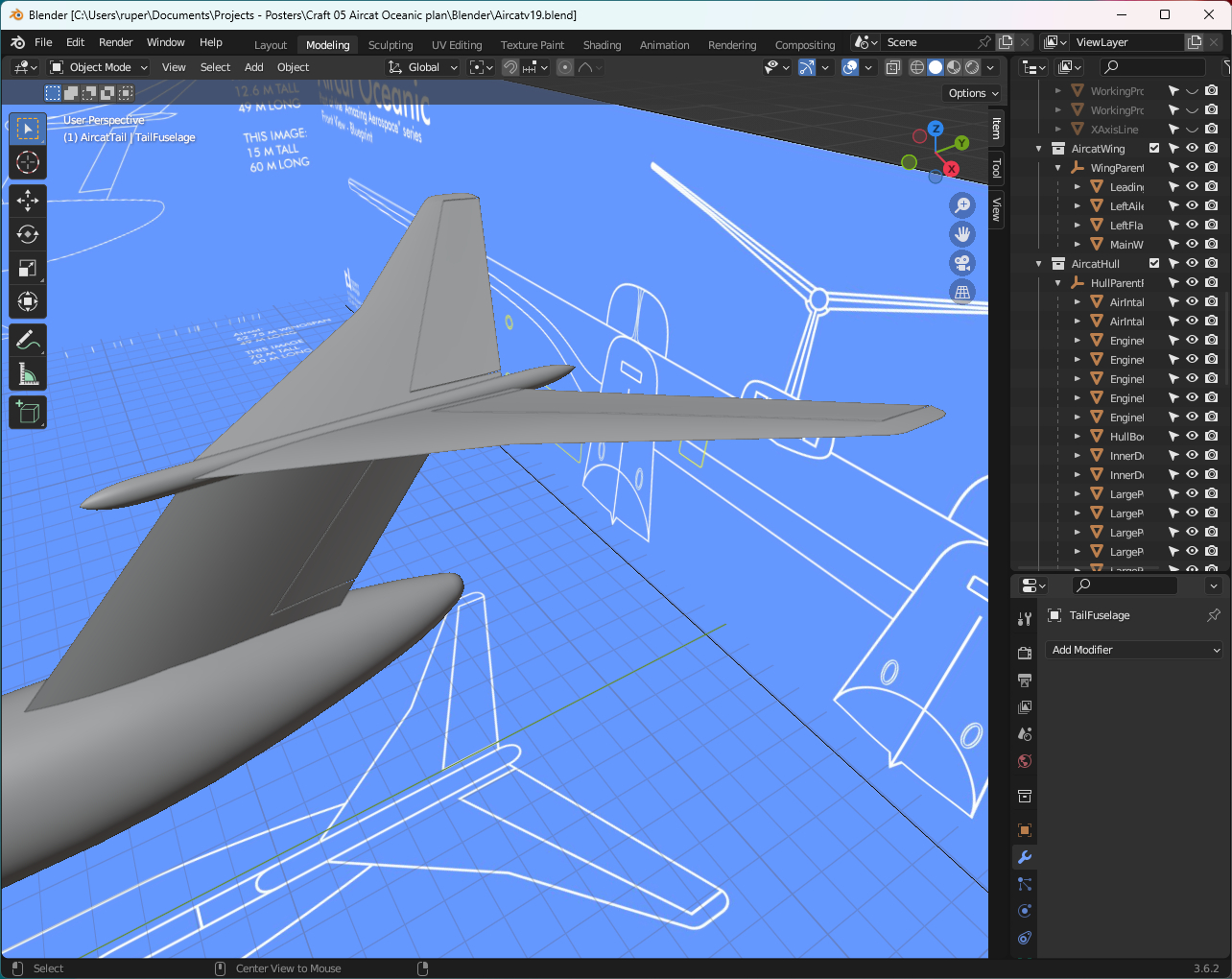
A complete Aircat is getting tantalising close. Together the parts modelled so far look like this:
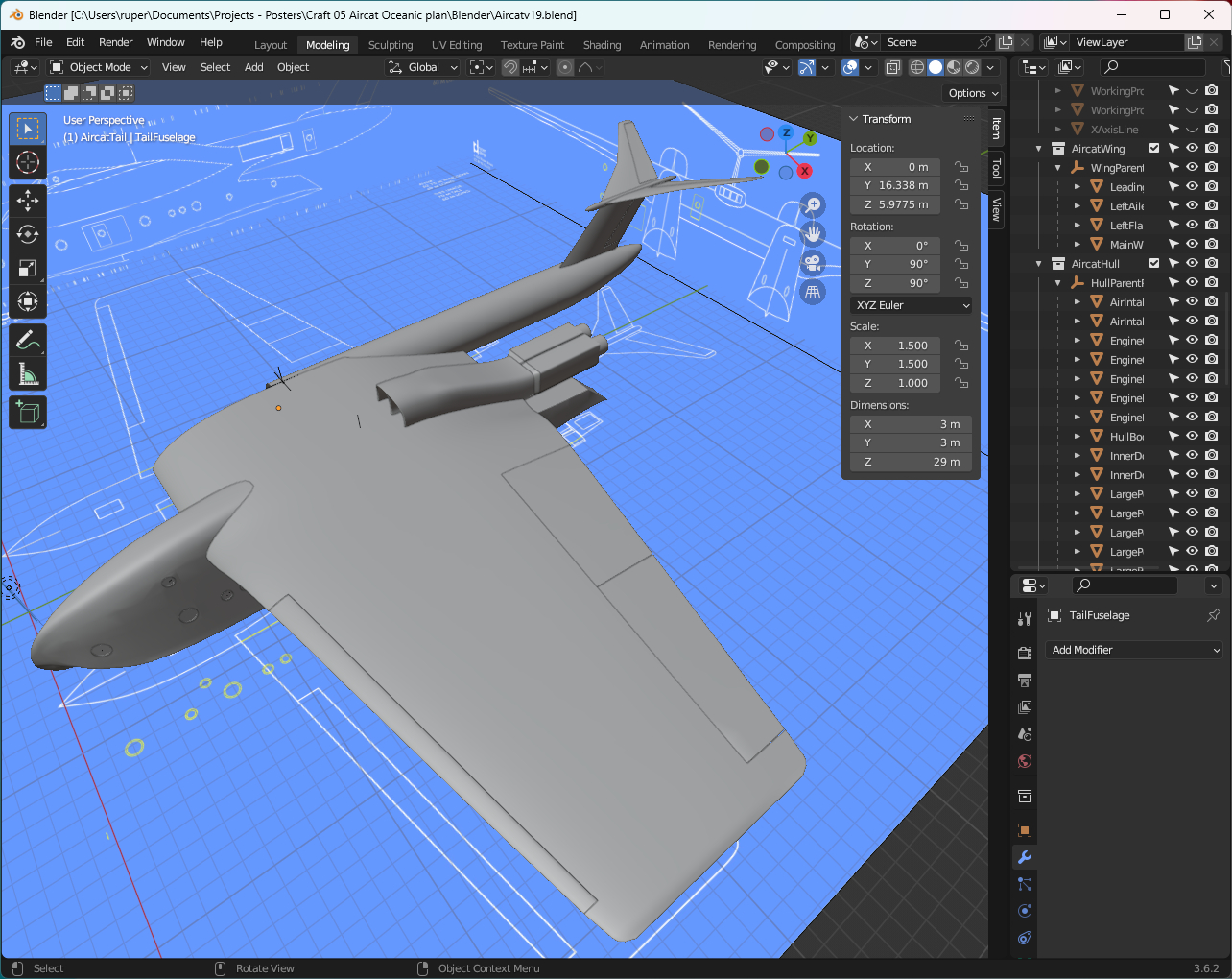
Aircat cockpit
28 December 2023
The Aircat cockpit sits on the top surface of the wing. The benefit is that the pilots are a long way from the water and spray, but they still need to be able to look down to the water to gauge their distance from the surface for landings and take-offs. To make that possible, the cockpit curves forward down the front of the wing - it has to curve at a higher rate than the wing profile. Going the other way, it gently curves its way to join the wing surface.
My first attempt was not successful. The strategy was to create a profile - the centre line side profile - and then extrude that sideways, shaping as I went. Two problems emerged:
- The back end was not a smooth gradient down to the wing surface - I ended up creating a ridge as a result of the way I manipulated the geometry.
- I was left with awkward geometry at the edge which I could see was not going to be resolved easily.
You can see those issues in the figure below:
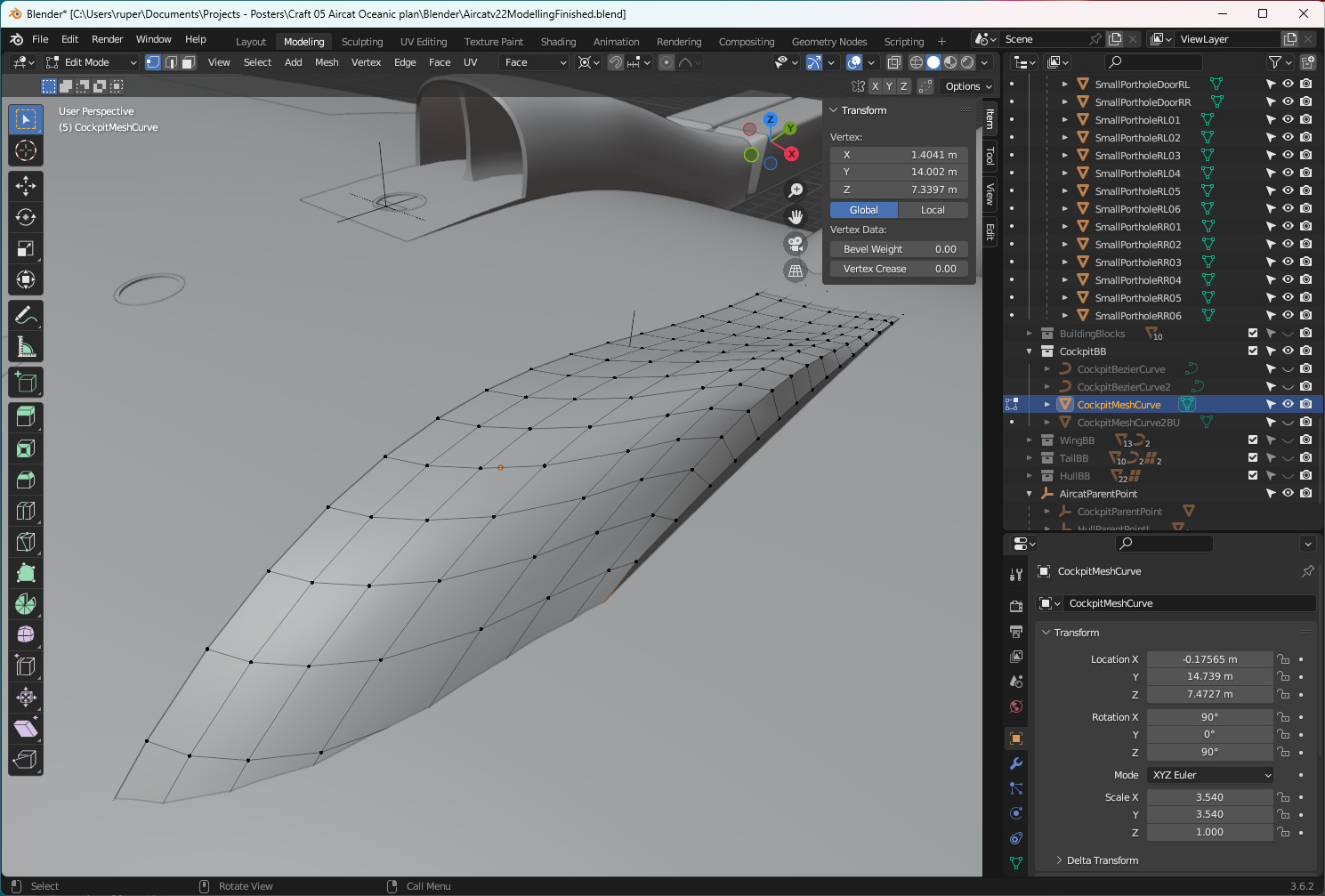
The solution lay in using a cross-section of the cockpit and extruding and shaping forwards and backwards - just as I had done with the hull section. That created a more manageable and malleable piece of geometry.
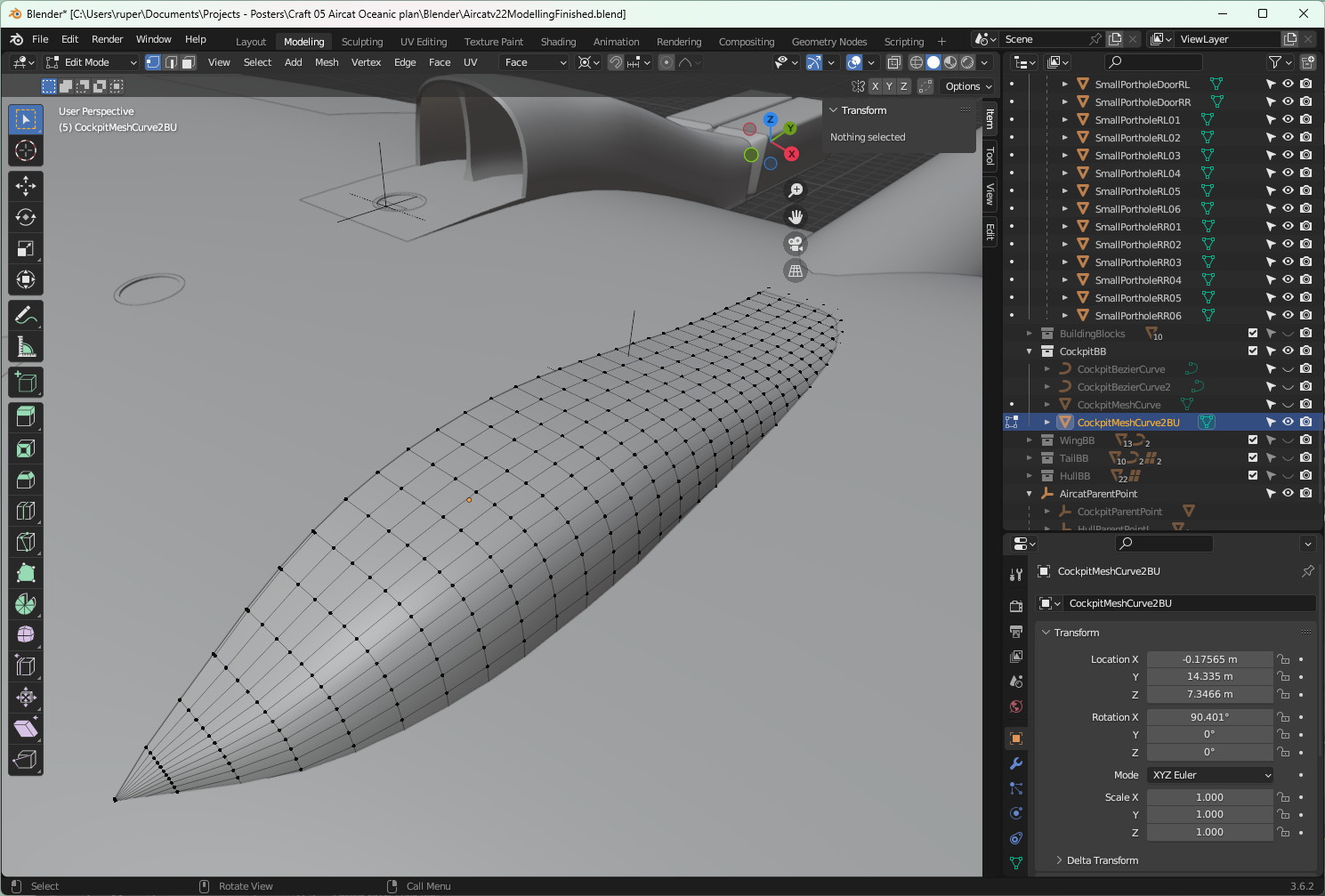
Into this shape I fitted the cockpit windscreen and portholes using my standard window technique, and a mirror modifier. The result:

This is the final result. I am quite pleased with that outcome. If I was going to change it, I might give it a less pointy nose - make the tip a bit broader.
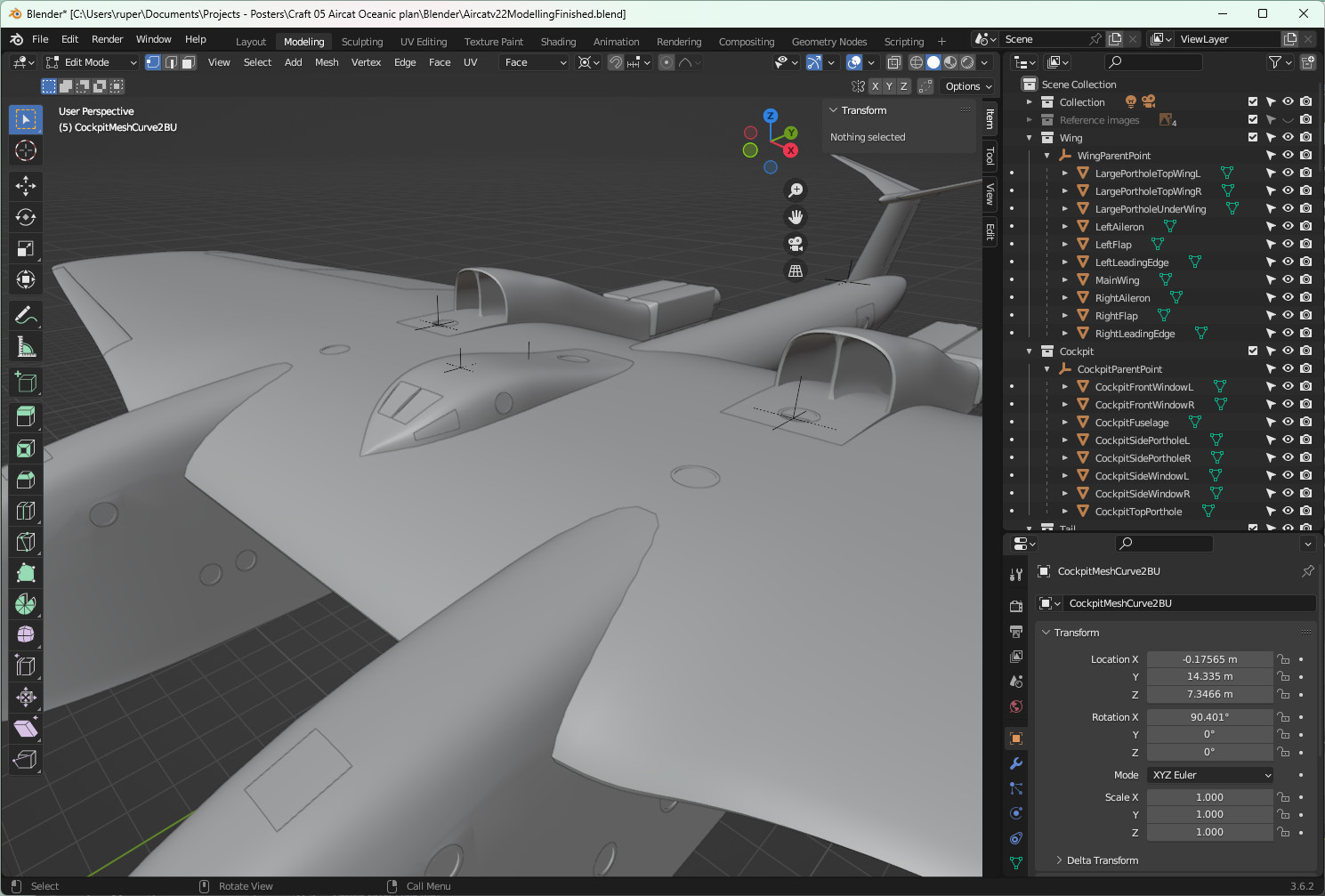
Aircat modelling complete
I finished Aircat's modelling! Well, you finish and then find you have to tweak something to fix a dodgy piece of mesh, or alter something to help with materials. Whatever, the modelling is finished.
I go through a "cleaning up" process, making use of the Outliner Editor, collections and parents. In the diagram below, in the Outliner on the right hand side, you can see I have created collections for the wing, cockpit, tail and hull. All the pieces of geometry that go to make up those components are properly named and included in the appropriate collection. As I'm modelling, I am always saving bits and pieces - I call these "building blocks" (BB) and I put them into their own collections. I know Blender has some good recovery tools if you make a mistake and need to revert to a previous version. With my BBs I'm just being a bit more proactive.
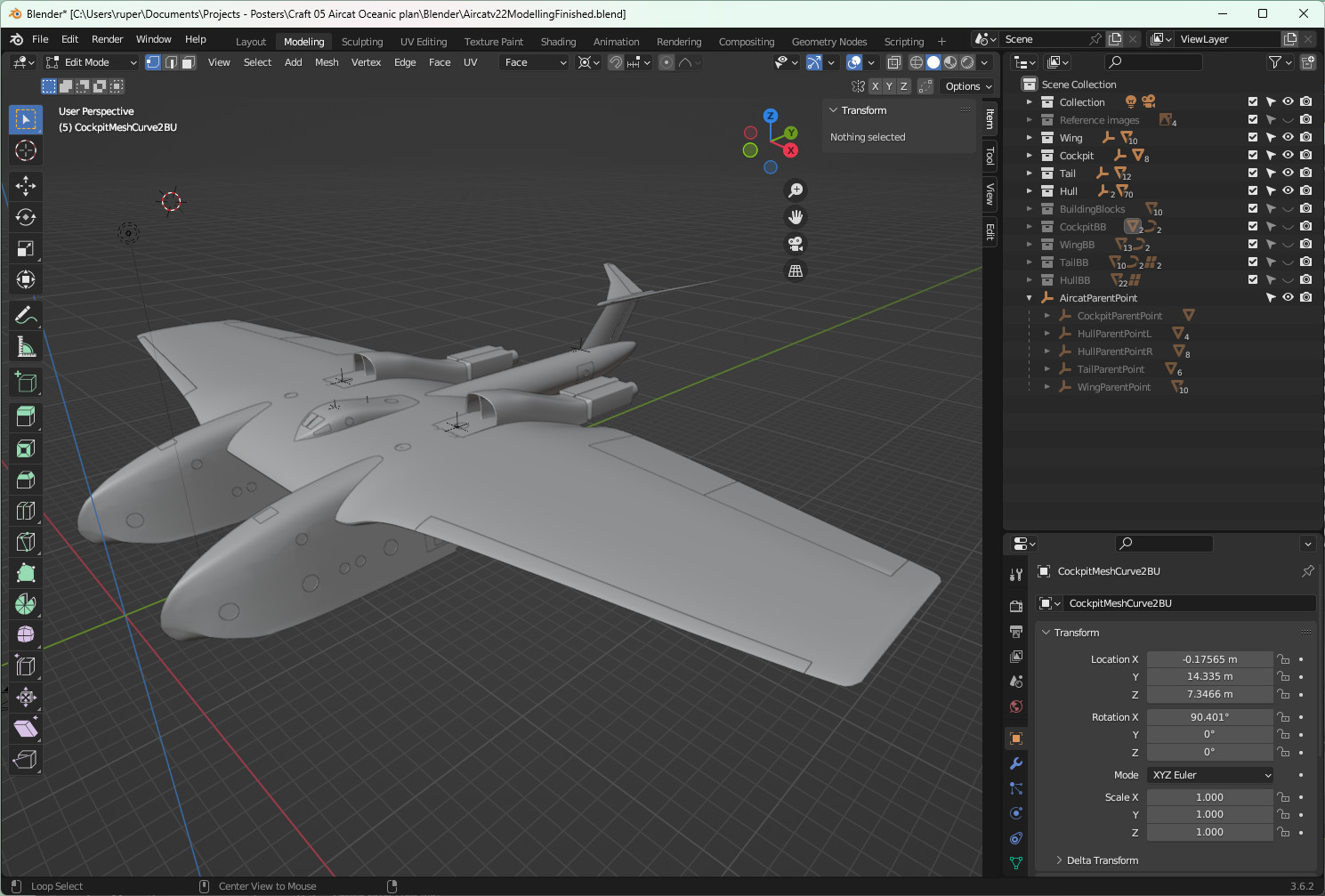
Within a collection, I add an Empty. This becomes my "parenting point". I parent all the parts of a significant component to the parenting point. That way I can move the component as a whole by moving the parenting point. Then I parent all the parenting points to a single model parenting point which makes moving the model around very easy.
For Aircat I have managed to be a bit more sophisticated with video. Below is a version of the "spinning model".
Materials
I've said before that I find creating and applying materials as complicated as modelling - but things are getting better. I took a Udemy course to improve my understanding. I haven't finished it yet, but it is helping.
One technique which I'm finding very useful, is the creation of an asset library. My models typically don't need complex materials because of the nature of my poster art. The final posters rely on areas of bold colours that don't have to contain a high level of detail or texture - so the materials themselves can be quite simple. I've started to use a kind of material 'display case' which is just a blend file with:
- A sphere to which you apply your material. A sphere lets you see the effect of the material on curves and at the diameter of the sphere - but you could pick whatever shape you like,
- A background that sits behind the sphere. You give this a colour that lends some contrast to the material you are developing,
- Lights. As many or as few as you like to illuminate your material so you can see how it will behave,
- A camera to get render results.
My display case looks like this:
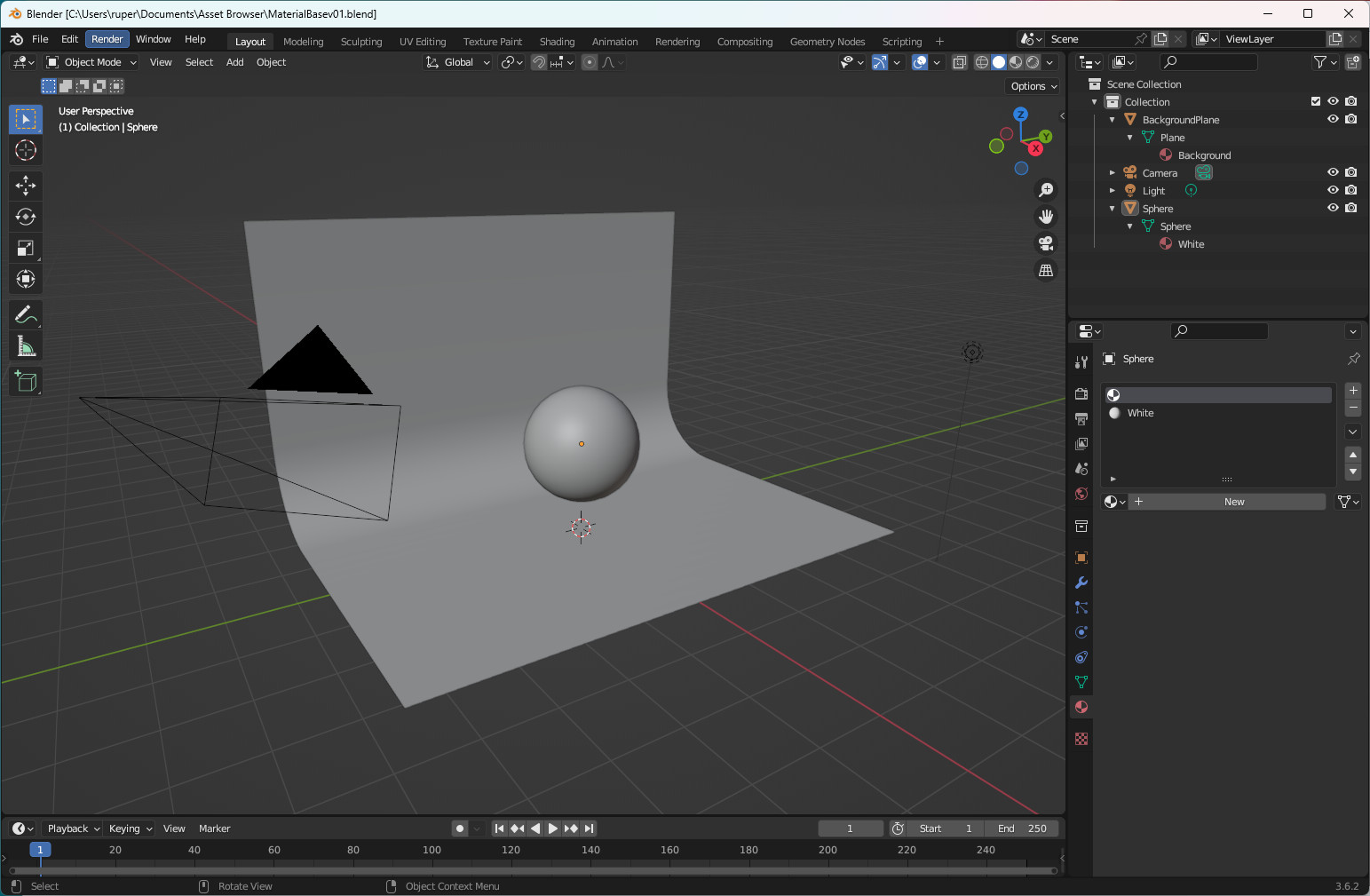
Once you have your display case blend file set up, you can make a copy (always do this) and then work on your material using the material nodes. This is where you can get very sophisticated - or in my case, very simple. Below is the display case for the dark blue colour I used on the bottom of the Aircat hull.
Once you are happy with the material, you can create your asset library:
- Decide where you want to put your assets - and when we talk about assets this can be materials or models. Come up with a directory name like AssetBrowser/Materials, whatever you want,
- In your display case material blender file, in the Outliner window, select the material you have created, right click and select 'Mark as asset'. In the Outline window a little bookcase type icon will appear against your material,
- Save your new display case material blender file into the directory you created to hold your assets, then
- Tell Blender where you are keeping your assets. Go to Edit > Preferences then on the left hand side of the pop-up window find and click on File Paths button. On the right hand side scroll to the bottom and find Asset Libraries and use the + button to add you new asset library name and below that the new path to that directory.
You will probably have to restart Blender for everything to align.
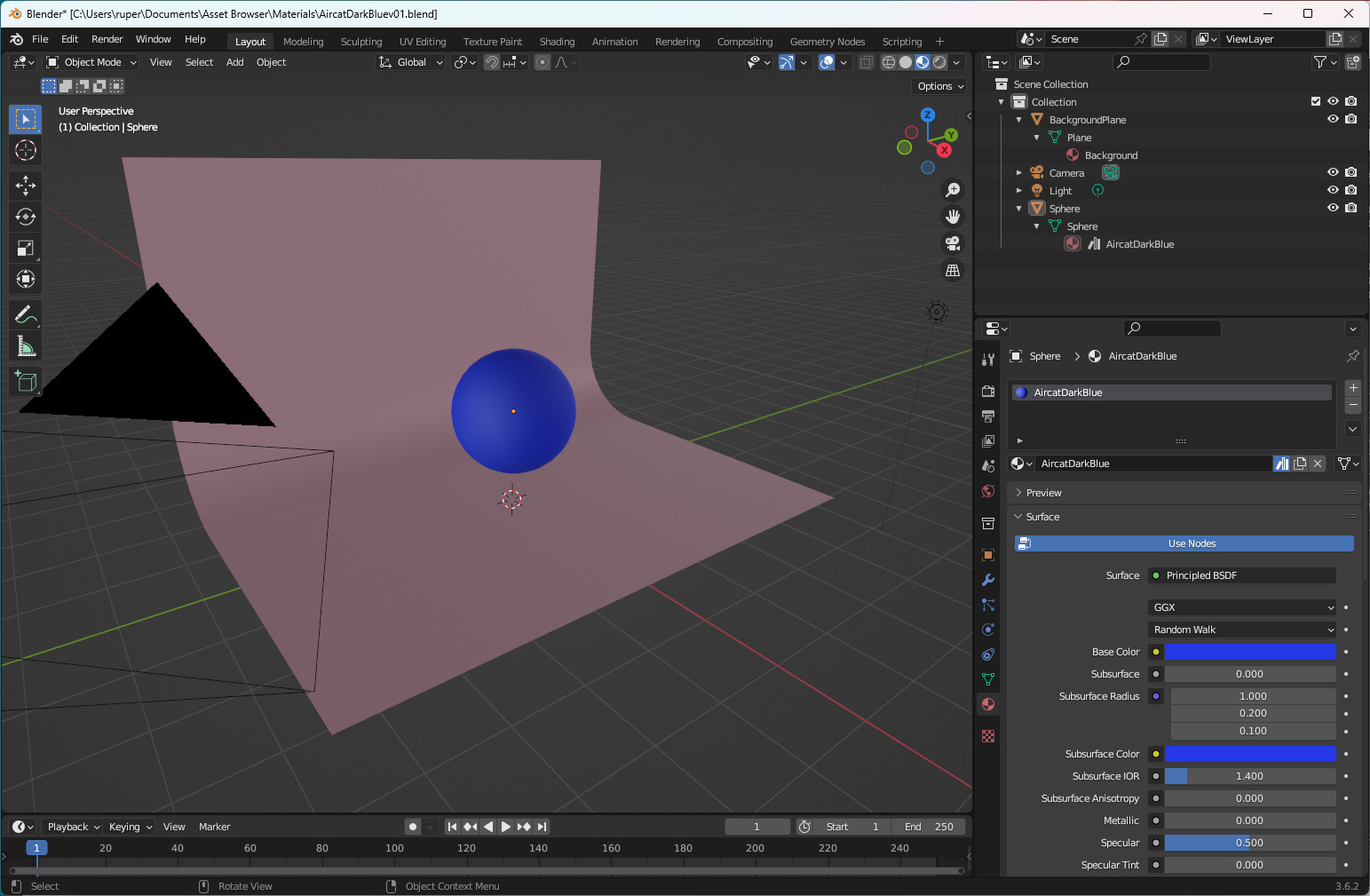
Now, when you want to start applying materials to your model you can open an Asset Browser window below your main window and, when in Object Mode, simply drag material assets from the Asset Browser onto your model to have them applied. If you want to apply a material to part of a mesh in Edit mode, you have to get Blender to understand where the material is. I create a random cube and apply the material to that. Then I find I can pick up the new material in the materials panel and apply it to specific faces in Edit mode. Don't forget to delete the random cube when you're done.
This is Aircat with the Asset Browser window open getting its materials:
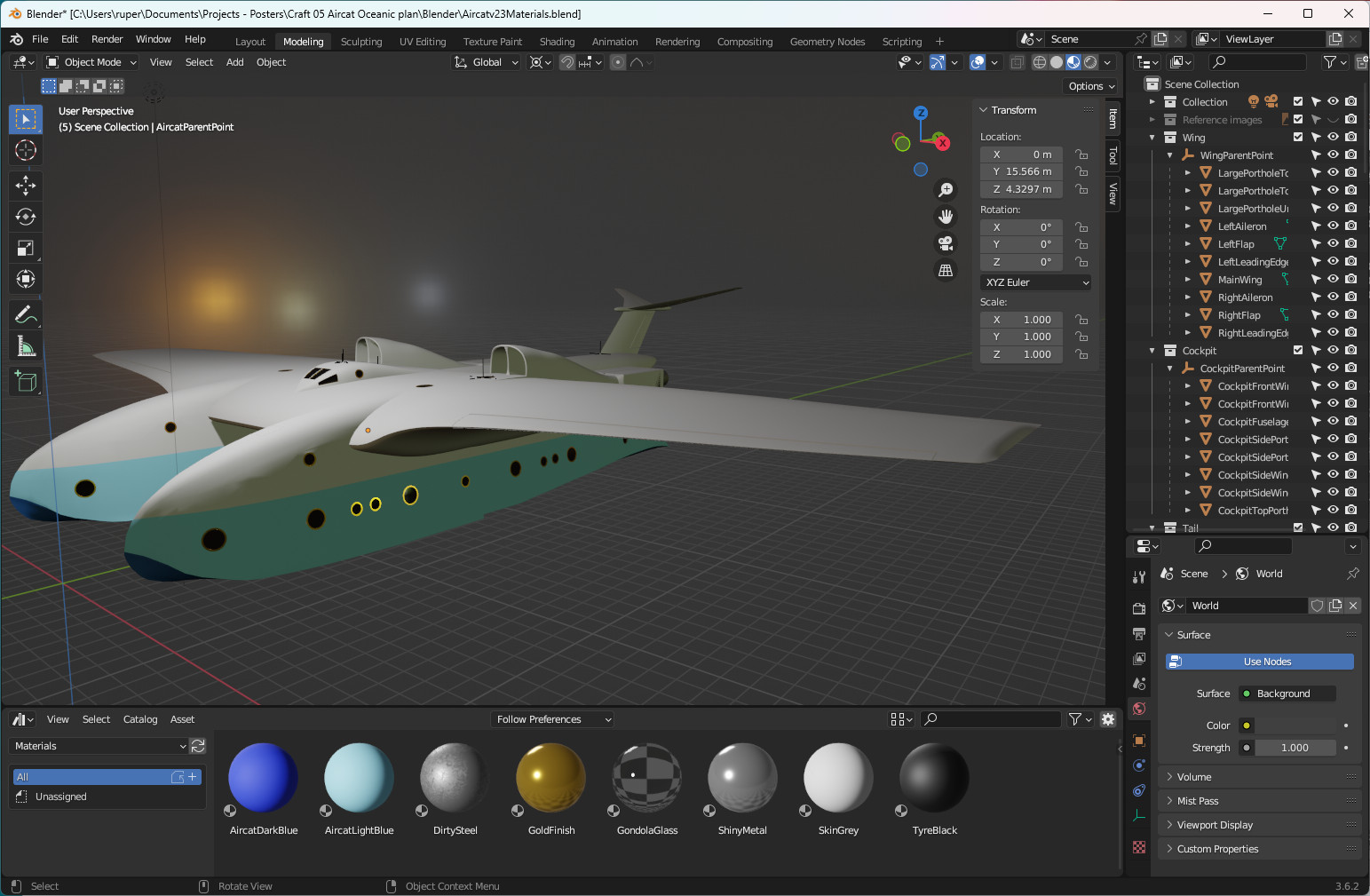
Applying decals
Decals are those images and text that most aircraft carry - serial numbers, operator logos, warning signs. In Blender, the most sophisticated and powerful way of doing this is to use the UV wrapping function. With that you seem to be able to achieve anything.
I'm using another technique which results in the logo (or whatever) being created as a mesh and incorporated into your model.
The process is based on Blender's ability to import a scaleable vector graphics (SVG) file. The curves and shapes in the svg file are readily translatable into Blender curves which is great but - make sure you are actually creating curves in your svg file. This can be a source of great frustration. Some applications simply embed images into svg files which don't work at all. Have a look at the image below:
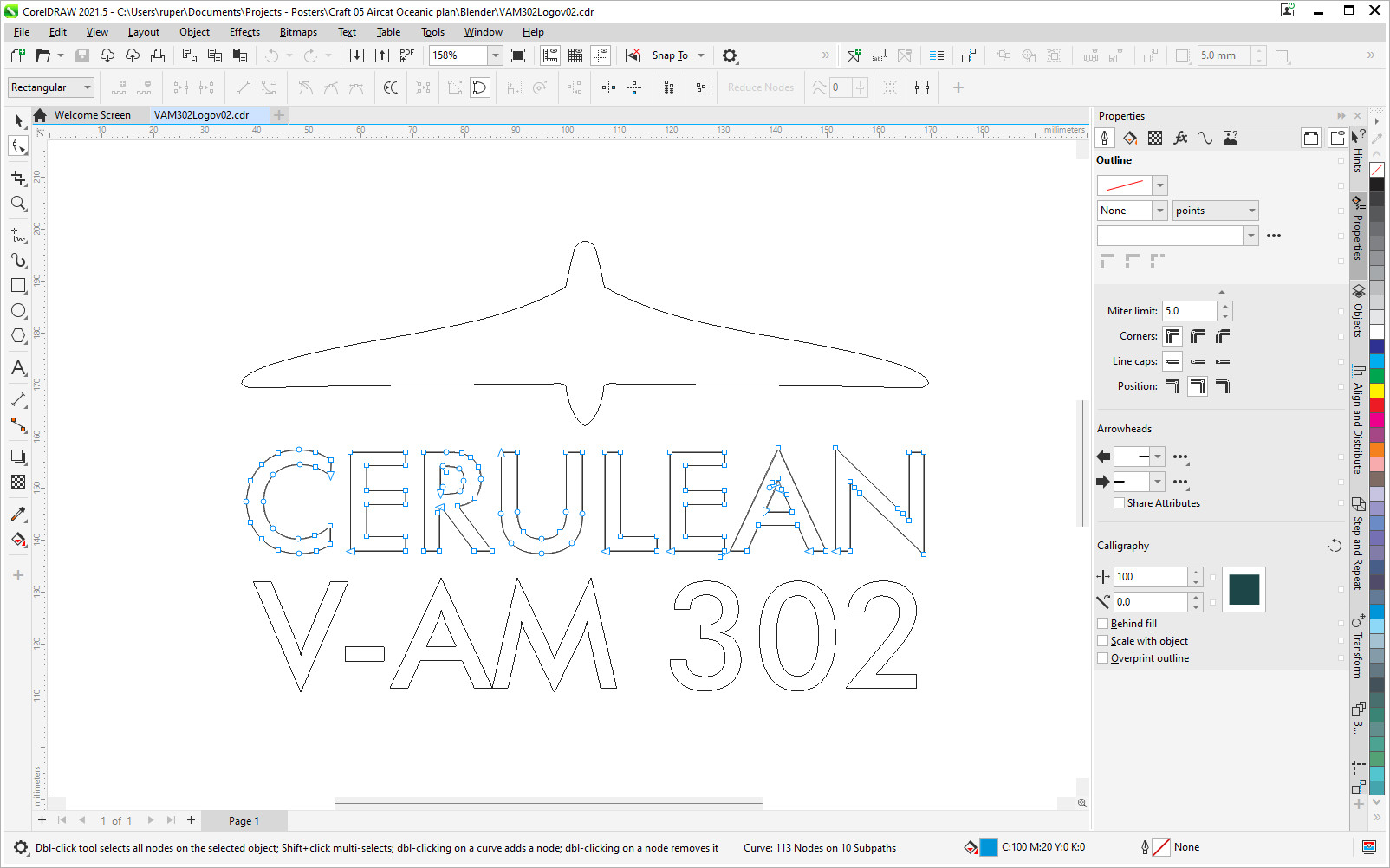
This is a screenshot from CorelDraw, but Inkscape and Illustrator probably work in very similar ways. The Cerulean logo is a curve. It is built from nodes and bezier curves. You cannot assume the same thing about the text. I have found that you have to explicitly turn text into curves using a Convert to curves function (or its equivalent depending on your application). If you don't, the Blender import doesn't work. In the case above you can tell the text is now a curve because the nodes linking the bezier curves are visible. Export your work as an svg 1.1 file. Make sure you have enabled the SVG 1.1 add-on in Blender.
If your file is well formed, once imported - File > Import > Scaleable Vector Graphics (SVG) - the curves will appear somewhere near the world origin and there is a good chance they will be tiny. Almost certainly you will need to zoom in and scale them up a bit to get to a point where they become easy to work with. This is typically what I do next to apply the svg image as a decal:
- Convert the curves to a mesh,
- The mesh will be a weird jumble of vertices, edges and faces in a single plane. I have no idea why they always turn out this way. Check that the faces you want are present and fix up if need be,
- If there are several distinct meshes that need to be manipulated as one, now is a good time to join them together,
- Put the 3D cursor on the part of the plane and then snap the svg mesh to the cursor to get the basic position right,
- Scale, rotate and move the svg mesh to get it to the right size, orientation and position. The mesh is going to be attached to a surface, so to the greatest extent possible align it with that surface,
- Go into Edit mode, select all the faces and extrude them away from the surface just a 'little bit'. This makes the mesh more than just a plane,
- For the svg mesh, apply all transforms and set Origin to geometry,
- Take a backup copy of your svg mesh and move it away - believe me, this is a really good idea because of the next step,
- Now the part which requires a bit of messing about - use a Shrinkwrap modifier to put the svg mesh onto the surface. Look at all the Shrinkwrap options to find the one that works best. Apply the modifier,
- There is a good chance it will look rubbish - for the svg mesh, go into Edit mode, select the top faces of the svg mesh (the ones you previously extruded), and move them away from the surface till you get a decent look i.e. no occlusion.
What could possibly go wrong? A lot - but so long as you have that back-up copy you can keep trying till it looks right, and it will. Apply a material and you're done.
You may find that it seems impossible to get a decent Shrinkwrap. If that is the case, use the Knife tool to add some more geometry to your svg mesh so that it can 'bend' easier to your Shrinkwrap surface. This is the result I got with Aircat.
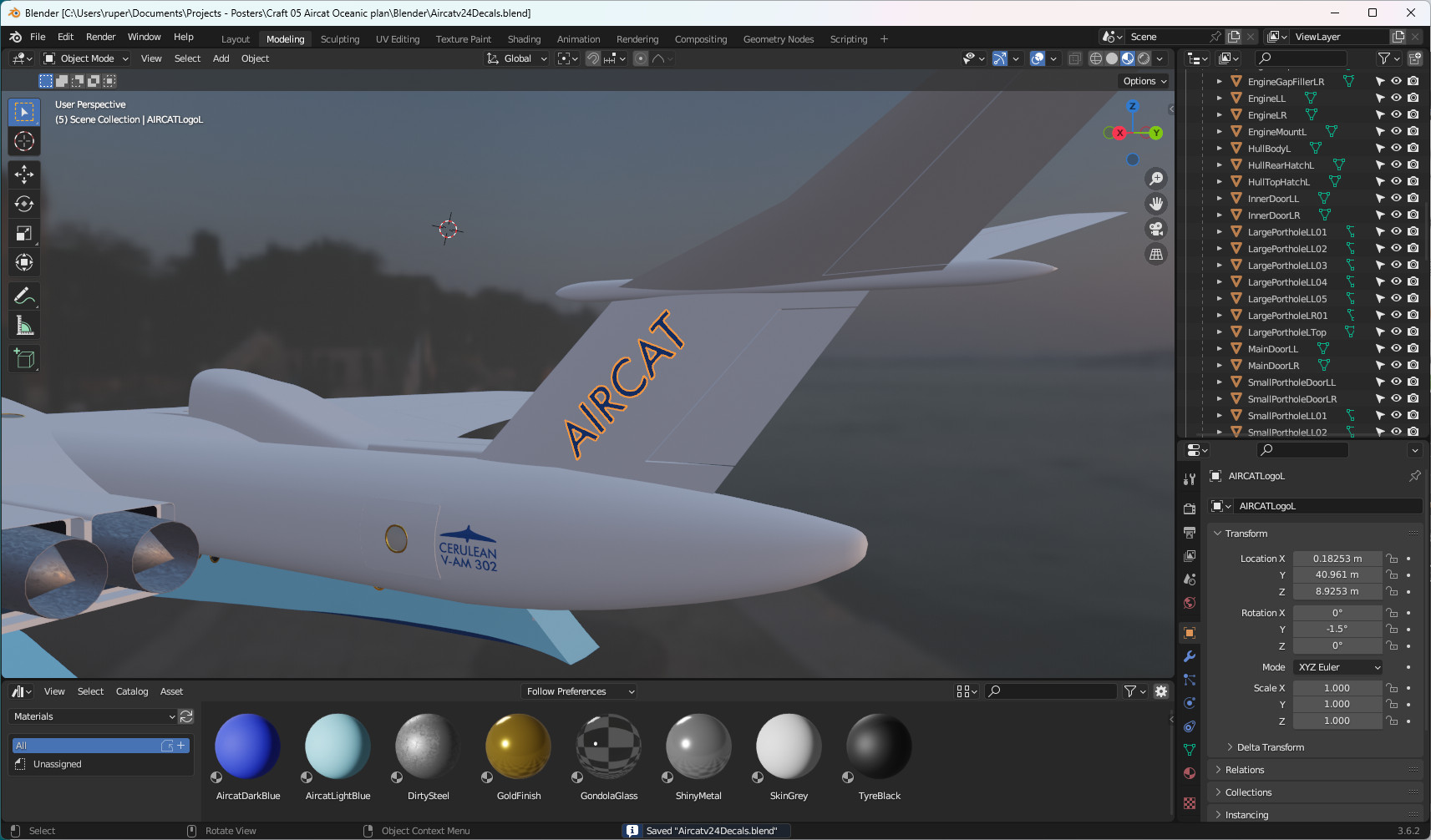
That is the end of the model builder. Time to start thinking of some posters. Click on the image below to view the completed 3D model in model-viewer.
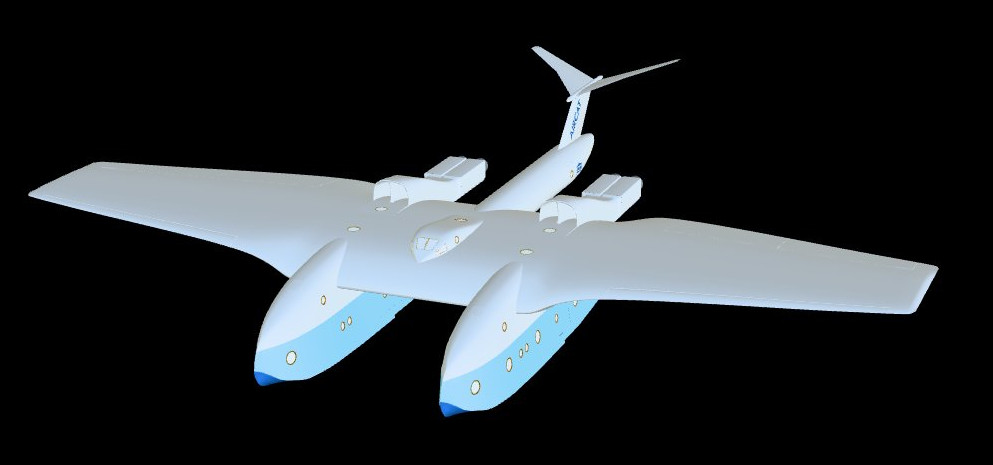
Back to top